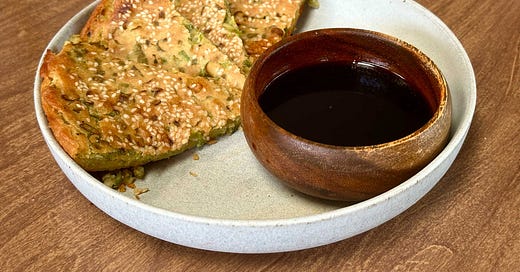Hey crew, and welcome back to Cool Beans! We’ve been on this food journey together for almost a year now, and if there’s one ingredient that’s been our MVP since the very beginning, it’s the chickpea. We’ve featured chickpeas in stews, burgers, and big, silky batches of hummus—even all on their own. Today, though, I’m exploring a whole other side to the almighty garbanzo. Chickpea flour has entered the weeknight dinner chat.
Chickpea flour pops up in cuisines from Italy to India to Burma (where it’s also used to make tofu), and there are ample reasons to stock it in your pantry. It has more protein than other flours (10 grams in ½ cup). It’s rich in fiber and naturally gluten-free with an earthy, nutty flavor. Plus, all that protein makes it sturdy enough to use in everything from baking pizza crusts to battering fritters. It also thickens when hydrated, so it’s a great binder or means to add heft to soups and gravies.
I’m using it in two simple dishes that will launch your legume lust to new heights. They’re easy to make, infinitely adaptable, and ready to fast-track your weeknight dinner routine. They’re also both natively free of all animal products.
The review: A fritter for all seasons
Chickpea flour—a.k.a. gram flour or besan—is the main ingredient in pakoras, spiced fritters eaten across Pakistan, India, and Bangladesh. Typically, they’re stuffed with onion or potato, but they can be a vessel for virtually any vegetable, from beets to summer squash to cabbage. They’re also the perfect place to hide greens for picky eaters. Me, I’ll eat pretty much anything, but I do from time to time wind up with some broccoli that I’m not exactly psyched to cook. Fritters, though? Fritters get me hype. To use up my sad, unwanted brassicas, I’m turning to these back-of-the-fridge pakoras from Great British Bake Off champion Nadiya Hussain.
This is a recipe where nothing goes to waste—even water. Broccoli, a couple onions, scallions, and a serrano chile hang out in a bowl with salt, turmeric, and coriander for about 30 minutes. If you’re making a veggie tart or quiche, the point here is to expel moisture and avoid a soggy bottom. In this case, though, the liquid from the veggies is what hydrates the chickpea flour to form a “claggy” batter, which you form into little mounds and fry in oil until golden and crispy.
Check out the full recipe for Nadiya’s anything-goes pakoras
Oh my god, I wish onion rings tasted like this. These pakoras are much lighter and crispier than your typical breaded veggie, since there is only just enough batter to hold the mix together. Also, because the fritters are fried in irregular clumps, they sizzle up into straggly little morsels that are utterly impossible to stop eating. (No joke, my first batch lasted 5 minutes.)
I loved them so much I made them again with grated, raw sweet potato—this time adding some cardamom and cinnamon to the mix. I could have kept going with every single veggie in my fridge, but I had splattered my stovetop with enough oil for one day. Besides, you can enjoy the pillowy benefits of chickpea batter without frying. Buckle up because the next stop on our tour is France, the home of a simple pancake known as socca.
The recipe: Pancakes for dinner, but make them savory
Ever since I learned that scallion greens will grow back when you put the bulbs in a cup of water, I’ve been sprouting green onion bouquets all around my house. It’s honestly more than any reasonable household of two can consume in a timely manner. I thought about making scallion pancakes but didn’t feel like busting out the rolling pin. Instead I decided to make a giant scallion pancake–inspired riff on socca, a French chickpea flatbread.
This bread, which originated in Nice, couldn’t be simpler to make and transforms in the oven into a pancake that’s crispy on the top and edges and fluffy in the middle. The batter itself is natively plant-based: nothing but chickpea flour, water, oil, salt, and pepper. No yeast. No kneading. Just chickpea magic. Similar to pakoras, you can treat socca as a vehicle for any excess veggies, greens, and herbs. Or you can leave out the filling and top them with a salad or pizza-fy them with a smear of pesto. The only catch is that you need to plan—just a bit: The batter has to rest for at least 30 minutes (and up to 24 hours), so you can even whip up the mix at night and have sunrise socca in the a.m. Just add a fried egg.
Sesame-Scallion Socca
Yield: 1 12-inch pancake (6 to 8 slices)






